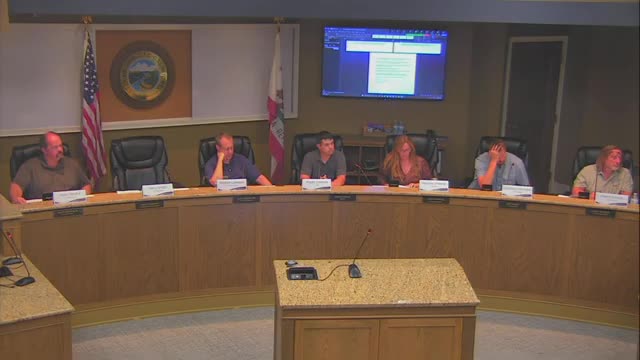City Council Discusses Use Permits for New Solar Projects and Drive-Thru Regulations
September 26, 2025 | Oroville, Butte County, California
This article was created by AI summarizing key points discussed. AI makes mistakes, so for full details and context, please refer to the video of the full meeting. Please report any errors so we can fix them. Report an error »

In the heart of Oroville's city hall, the Planning Commission convened to discuss the future of solar energy projects in the area, a topic that has sparked both interest and debate among local officials. As the meeting unfolded, the focus turned to a significant 100-acre solar project, categorized as tier 3 and intended exclusively for commercial use. The commission's staff recommended that all tier 3 solar projects continue to require use permits, a measure aimed at ensuring thorough reviews of their potential impacts on the community.
The discussion highlighted the current regulations, which stipulate that solar panels can cover a maximum of 30% of a parcel. However, some members expressed concerns that this standard may no longer be reasonable, especially as new applications emerge. Notably, two additional solar permit applications were introduced: one from SCORE, which seeks to expand its existing solar farm, and another from Sierra Pacific, aiming to enhance its energy consumption through solar solutions. The rising costs of energy from PG&E have intensified the urgency for such projects, particularly in Oroville's industrial and commercial sectors.
While the commission proposed to keep the tier 2 and tier 3 regulations unchanged, they did suggest an administrative permit for tier 2 ground-mounted solar projects in residential zones. This adjustment would allow for better control over lot coverage, which is capped at 50% in residential low-density zones and 60% in residential single-family zones.
A notable point of contention arose regarding the placement of solar projects in commercial neighborhoods. Some commissioners voiced their preference to restrict solar installations in these areas, arguing that commercial zones should prioritize business development rather than solar energy projects. The limited availability of commercial neighborhood spots further fueled this sentiment, with concerns about the potential impact on residential areas.
The conversation also ventured into innovative ideas, such as the possibility of utilizing large parking lots for solar carports. While some members debated whether these structures would be classified as ground-mounted or roof-mounted, the consensus leaned towards recognizing them as a smart solution for maximizing solar energy use without sacrificing valuable land.
As the meeting concluded, the commission's discussions underscored the delicate balance between promoting renewable energy and addressing community concerns. With the landscape of solar energy in Oroville evolving, the decisions made in these meetings will undoubtedly shape the city's energy future and its commitment to sustainability.
The discussion highlighted the current regulations, which stipulate that solar panels can cover a maximum of 30% of a parcel. However, some members expressed concerns that this standard may no longer be reasonable, especially as new applications emerge. Notably, two additional solar permit applications were introduced: one from SCORE, which seeks to expand its existing solar farm, and another from Sierra Pacific, aiming to enhance its energy consumption through solar solutions. The rising costs of energy from PG&E have intensified the urgency for such projects, particularly in Oroville's industrial and commercial sectors.
While the commission proposed to keep the tier 2 and tier 3 regulations unchanged, they did suggest an administrative permit for tier 2 ground-mounted solar projects in residential zones. This adjustment would allow for better control over lot coverage, which is capped at 50% in residential low-density zones and 60% in residential single-family zones.
A notable point of contention arose regarding the placement of solar projects in commercial neighborhoods. Some commissioners voiced their preference to restrict solar installations in these areas, arguing that commercial zones should prioritize business development rather than solar energy projects. The limited availability of commercial neighborhood spots further fueled this sentiment, with concerns about the potential impact on residential areas.
The conversation also ventured into innovative ideas, such as the possibility of utilizing large parking lots for solar carports. While some members debated whether these structures would be classified as ground-mounted or roof-mounted, the consensus leaned towards recognizing them as a smart solution for maximizing solar energy use without sacrificing valuable land.
As the meeting concluded, the commission's discussions underscored the delicate balance between promoting renewable energy and addressing community concerns. With the landscape of solar energy in Oroville evolving, the decisions made in these meetings will undoubtedly shape the city's energy future and its commitment to sustainability.
View full meeting
This article is based on a recent meeting—watch the full video and explore the complete transcript for deeper insights into the discussion.
View full meeting
